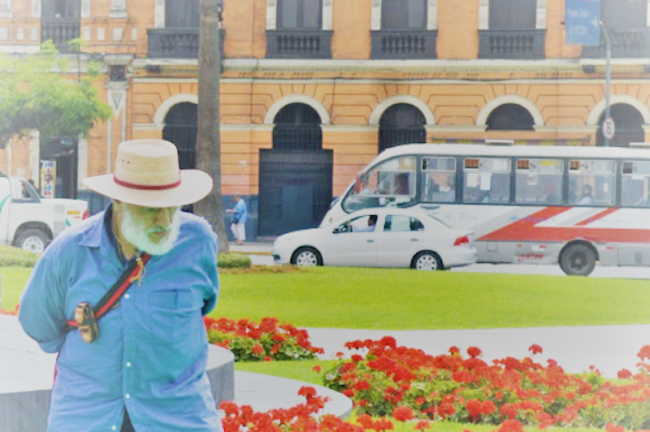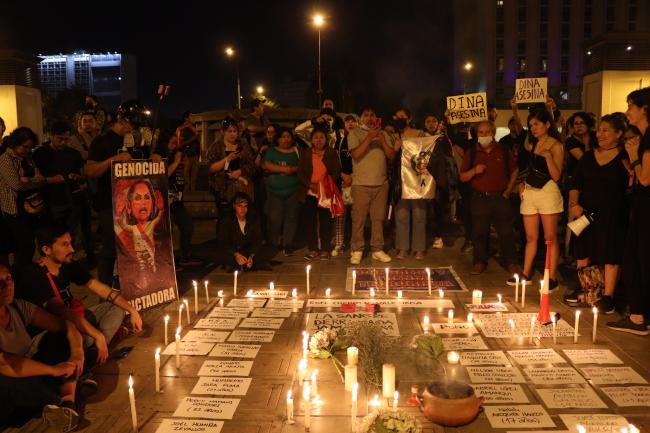
One of Peru’s most enigmatic figures became an ancestor at the age of 88: Hugo Blanco Galdó—known as Tayta, a Quechua term of respect meaning paternal figure—passed away in a small city just outside of Stockholm, Sweden on June 25. Blanco was a campesino organizer from the region of Cusco. His long life cut across the defining socio-political epochs not only of Peru but of the entire continent.
At a time when Peru is undergoing the most significant governing crisis in a generation, revisiting Blanco’s life in different political eras contextualizes today’s movement within a broader historical struggle.
Protracted State Violence
“Puno is not Peru,” said president of Perú Dina Boluarte at the end of January this year. In just a few words, Boluarte alienated a region and its majority Indigenous population, perpetuating dismissive attitudes the Peruvian state has long held towards the Indigenous peoples and regions of Perú Profundo, or deep Peru. Paternal attitudes and demonization define state engagements with Peru Profundo’s Indigenous populations. State responses to the latest rebellions in southern Peru have been dismissive at best, and repressive at worst: violent crackdowns, killings and torture of Indigenous demonstrators sustained by racist dismissals in the press, and various sectors of society viewing their pleas for justice as the petulant cries of an ignorant class. Historically perceived as anachronistic communities, the Quechua, Aymara, and other Indigenous peoples of the Andean and Amazonian regions have been perceived as invisible—citizens only in name.
This most recent expression of material and rhetorical violence in Peru is nothing new: it stands on a long history of anti-Indigenous sentiments alongside neoliberal models of development the governing class has embraced. Much of this history has been obscured as the state has relied on telling a singular history defined by criollo elites who only recognize state-level politics. The Andes and other subaltern spaces tell the stories of other realities and struggles, helping us to examine history “from below” or from the margins. Blanco is one of the most prominent figures involved in these histories from below.
Blanco’s journey through the contours of Peruvian politics serves as a lens through which to observe and analyze both Peruvian state politics and various forms of resistance. Pushing beyond state-politic limitations, much can be learned from Blanco’s historical struggle, including his reinvention and appreciation for Pachamama Andean politics and cosmology.
Born on November 15, 1934, in Parura, a town outside of Cusco, Blanco witnessed the mistreatment of Indigenous and campesino workers early in his life. This era represented the height of the hacendado in Peru, where large landowners utilized semi-feudal patronage systems to exploit Andean peasant communities. The haciendas, or landed estates, were large land holdings inherited from the colonial period. Wealth was in the hands of the criollo elite who maintained what was known as the colonato servil, in which campesinos were servants for landowners.
Seeing how campesino struggle was rooted in the land, Blanco took up interest in crop management, recognizing that campesino and peasant freedom could come through land redistribution. At age 20 he traveled to Buenos Aires to study agronomy, where he quickly became acquainted with Latin America’s growing Trotskyist movement.
Influenced by Trotsky’s international revolutionary socialist organization the Fourth International, Blanco spent his early political life organizing a vanguardist movement back in his native Cusco, led and organized by a class of the most politically conscious sectors of society. He saw social and political organizing as the only path for revolution. He would leave university after two years, first attempting to organize factory workers before making his way to the Peruvian province of La Convención to join a growing peasant rebellion.
Following Trotskyism, Blanco saw cultivation of a vanguard at the behest of an organized populace as the clearest path to freedom from oppressive hacendados. He founded the local peasant union responsible for organizing those working on the haciendas, mostly Indigenous, Quechua-speaking campesinos. He became a leading figure in the 1961 agrarian movement in which “Ota allpa otac huañuy!” (Land or death!) became the rallying cry that reverberated throughout the Andean valleys. This struggle is documented in his 1967 book, Land or Death. A highly influential text, it brought the Peruvian peasant struggle into the fold of the land reform movements and political upheavals of the time, even gaining admiration from Che Guevara. Following unsuccessful strikes to force landowners to negotiate with campesinos, Blanco, along with other organizers of the time, moved to armed resistance to pressure landowners. Although Blanco and his group were imprisoned, the government soon realized repression would only lead to increased insurrections in the region. Initially passing a localized agrarian reform, the government of Juan Velasco Alvarado reluctantly passed the Agrarian Reform of 1969 which divided and parceled out landholdings throughout Peru.
Although it was one of the largest Agrarian Reforms passed in the Americas, it was not radical. Rather, latifundios—large parcels of land owned by single estates without the exploitative labor found on haciendas—kept much of the socio-economic structure intact. The hacendado class morphed into a business; the bourgeoisie established itself in a nascent neoliberal economy.
Blanco was in prison when the reform was passed and was deported by Velasco for turning down multiple offers to work with the government. He saw through Velasco’s attempt to win over sympathies from the unions and peasant organizations and bring them into the fold of the state to the benefit of the ruling criollo class, viewing the reform as another form of state capture and appropriation. “I took this approach because I knew that Velasco’s agrarian reform, even if progressive, since it eliminated the latifundio, would be bureaucratic, dictated from their offices without consulting the campesinos.” Blanco foreshadowed the rise of leftist oligarchies, referred to as the Izquierda caviar in Peru, the parties that are nominally left while presiding over neoliberal development. This is not just emblematic of Peru; nominally left parties preside over many Latin American countries today.
After winning elections for the Constitutional Assembly, the Peruvian government was forced to allow Blanco back into Peru in 1975, before arresting him again for calling a national strike to garner support for a new constitution. At this point Blanco pushed the idea of dual power: actively engaged grassroots mobilization can force a governing body to act, keeping it accountable while maintaining the former’s autonomy. This was the late 70s and Latin America was entering its “Lost Decade,” a period of economic decline due to unpayable debts and internal conflicts.
By the late 1980s, as Sendero Luminoso (Shining Path) began unleashing its Maoist campaign of terror, Blanco was elected to congress and committed himself to formal politics. One of the last Marxist-Leninist guerilla groups of the continent, the Shining Path sought to bring about a communist revolution through a “people’s war” from the countryside. Both Peruvian state intelligence and the Shining Path rejected critiques from the Andean and broader Indigenous political movements. Both targeted Blanco. The state saw him as a usurper and Shining Path sympathizer, though he fiercely denounced the Shining Path’s violent scorched earth practice. Sendero Luminoso, on the other hand, viewed Andean thinkers like Blanco as backwards protocapitalists susceptible to capitalist ideology. Targeted by both, Blanco was driven to self-exile, spurred by the coup of Alberto Fujimori, the now-imprisoned former dictator who in 1992 used the pretense of combating Shining Path terrorism to purge the country of critics.
Exiled to Mexico in 1992, Blanco watched from afar as Fujimori’s regime codified neoliberal reforms in the 1993 constitution, including the privatization of various industries. The constitution facilitated the granting of territorial concessions to mining companies and undid the few progressive elements of the 1969 Agrarian Reform. Much like Pinochet’s constitution in Chile, the Peruvian constitution tightened neoliberalism’s grip on the country, leaving behind a legacy of inequality and economic exploitation that is still felt today.
Blanco coincidentally found himself near Chiapas in 1994 where an organized group of masked Indigenous and mestizo campesinos emerged from the Lacandon Jungle and introduced the world to Zapatismo—a neo-Indigenous, autonomist, and bottom-up politic originating from post-Marxist guerrilla movements and the Indigenous peoples of Chiapas.
Zapatismo reaffirmed Blanco’s idea that power did not only emanate from the state but was created from below. Like the Zapatistas’ “inward turn” towards Zapotec, Mixtec and other Indigenous cosmovisions or worldviews, Blanco realized that external frameworks of revolution were being clumsily applied to places or contexts like the Andes. He realized it was not the politic of Lenin or Trotsky that informed his praxis, but rather his early upbringing in Andean cosmovisions and ways of life, a process of recovering the knowledges that capitalism took from us. From then on, he unapologetically centered Pachamama—earth politics, to put it crudely—and moved away from developmentalist mindsets that even the most progressive “alternatives” maintained. “Was the fight for the land right at the time? Of course, it was right… And now, the issue is no longer ‘Land or Death’… now it is a struggle against the poisoning of mother earth,” said Blanco. He would go on to say that revolution is not about changing human nature but “recovering human nature.”
Described as politics of degrowth, ecosocialism, and more, Blanco’s later politics could also be thought of as the politics of life upholding the virtues of Sumaq Kawsay or Buen Vivir—Live well or wellbeing, in English.

On Peru’s Independence Day, July 28, the third “takeover” of Lima took place: thousands descended from the southern provinces—the same provinces that Blanco had trekked—to the capital to denounce President Boluarte. Once again, thousands of police were mobilized as Boluarte called upon congress for more expansive powers. In response to the third mobilization against her regime, Boluarte’s extended the state of emergency in Puno for an additional 30 days on August 5. This latest state of emergency authorizes warrantless searches and restricts the right to free association and free transit.
Today as the struggle for life carries on across Peru, Latin America, and elsewhere, those of us concerned with bringing about a different world can draw from the life and experiences of people like Blanco. Blanco’s constant reinvention and ability to caminar preguntando—what the Zapatistas describe as the practice of questioning as one journeys through life—allowed him to learn from and recognize the politics of everyday life. Blanco was never afraid to learn from his experiences, including the different encounters he had in the countless campesino communities he interacted with, that would help unsettle even his strongest convictions and prefigurative politics. For Blanco, it meant understanding the roots from where one came, “Knowing our past helps us find the path of our future. It is not a matter of repeating what has already happened, as now is another age, and humanity has travelled and learned a great deal. But roots are roots, and they determine the form of growth of the tree.”
Tupananchiskama, Tayta Blanco. Until life has us meet again.
George Ygarza is a researcher, popular educator, and a Mellon Postdoc at the University of Pennsylvania.

